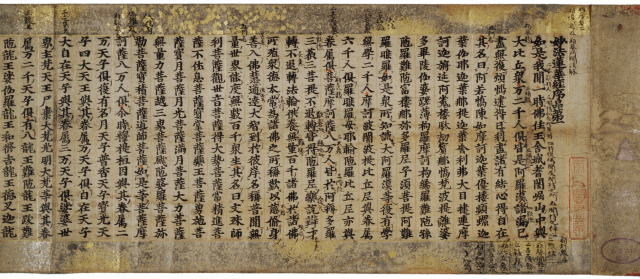 The Lotus Sutra is one of the central texts in the Mahayana tradition of Buddhism and, for some, is thought to contain the complete and final teaching of the Buddha. It was composed at the turn of the millennium.
The Lotus Sutra is one of the central texts in the Mahayana tradition of Buddhism and, for some, is thought to contain the complete and final teaching of the Buddha. It was composed at the turn of the millennium.
In 12th century Japan, Buddhists began to print portions of this sutra on the backs of letters from those who had died—as a form of prayer for the loved one’s soul. The letter pictured here, with the text of the sutra decorated with flecks of gold or silver leaf, was written by Daitō Genchi, the second abbot of Kakuon-ji Temple in Kamakura, and likely dates from the early 14th century.
I don’t know what portion of the sutra is printed here, but one remarkable feature of the Lotus Sutra is that it preaches that all beings have the potential to become Buddhas—including women, animals, and those who have committed evil deeds. It also reverses the doctrine that required eons of practice and sometimes rebirth to become a Buddha, teaching that enlightenment is possible in one’s present life at any time.
This is dramatized in the 12th chapter, with an argument between Shariputra, one of the Buddha’s disciples, and an eight-year-old girl, the daughter of the Dragon god:
At that time, Shariputra spoke to the Dragon Girl, saying, “You claim quick attainment to the supreme path. This is difficult to believe. Why? The body of a woman is filthy and not a vessel for the Dharma. How can you attain to supreme Bodhi? The Buddha Path is remote and distant. Only after one has passed through limitless eons, diligently bearing suffering and accumulating one’s conduct, perfecting one’s cultivation of all Paramitas, can one then attain realization. What is more, a woman’s body has five obstacles: one, she cannot become a Brahma Heaven King; two, she cannot become Shakra; three, she cannot become a Mara King; four, she cannot become a Wheel-turning sage king; five, she cannot become a Buddha. How can a woman quickly realize Buddhahood?”
Now the Dragon Girl had a precious pearl, its worth equal to the entire system of three thousand great thousand worlds, which she took before the Buddha and presented to him. The Buddha immediately accepted it. The Dragon Girl said to Wisdom Accumulation and the Venerable Shariputra, “I just offered up this precious pearl and the World Honored One accepted it. Was that quick or not?”
“Very quick!” they answered.
The girl said, “With your spiritual powers, watch as I become a Buddha even more quickly than that!” At that moment, the entire assembly saw the Dragon Girl suddenly transform into a man and perfect the Bodhisattva conduct. Instantly she went off to the south, to The World Without Filth, where, seated on a jeweled lotus, she accomplished equal and proper enlightenment and embodied the thirty-two marks and eighty minor characteristics. There, for the sake of all living beings throughout the ten directions, she proceeded to proclaim the wonderful Dharma.
While the Bodhisattvas, Hearers, gods, dragons, and the rest of the eightfold division, both humans and non-humans in the Saha World all watched from a distance as the Dragon Girl became a Buddha and spoke the Dharma for all the gods and humans. They rejoiced exceedingly and reverently made obeisance from afar. Hearing that Dharma, limitless living beings understood and awoke, attaining to irreversibility. Countless living beings received predictions of the Way. The World Without Filth quaked in six ways, while in the Saha World, three thousand living beings came to dwell on the ground of irreversibility, and three thousand living beings brought forth the Bodhi mind and gained predictions.
Wisdom Accumulation Bodhisattva, Shariputra, and the entire assembly silently believed and accepted.



awake awake now is the time
LikeLiked by 1 person
Reblogged this on Seek the Roots.
LikeLiked by 1 person
Great — glad you liked it!
LikeLike
Pingback: 1605: Not the Author of Don Quixote |